The name, “Lipstick Plant” is inspired by the plant’s vivid tubular red blooms sprouting from burgundy buds that resemble a tube of lipstick.
Clusters of blooms and green, waxy leaves on growing vines cascade downward, making them ideal as houseplants and hanging flower pots.
Cultivating a lipstick plant is not difficult, and with the right care, you get bright, colorful blooms all year long.
In this post, I will cover how to care for lipstick plants and how to grow them.
Lipstick Plant Overview
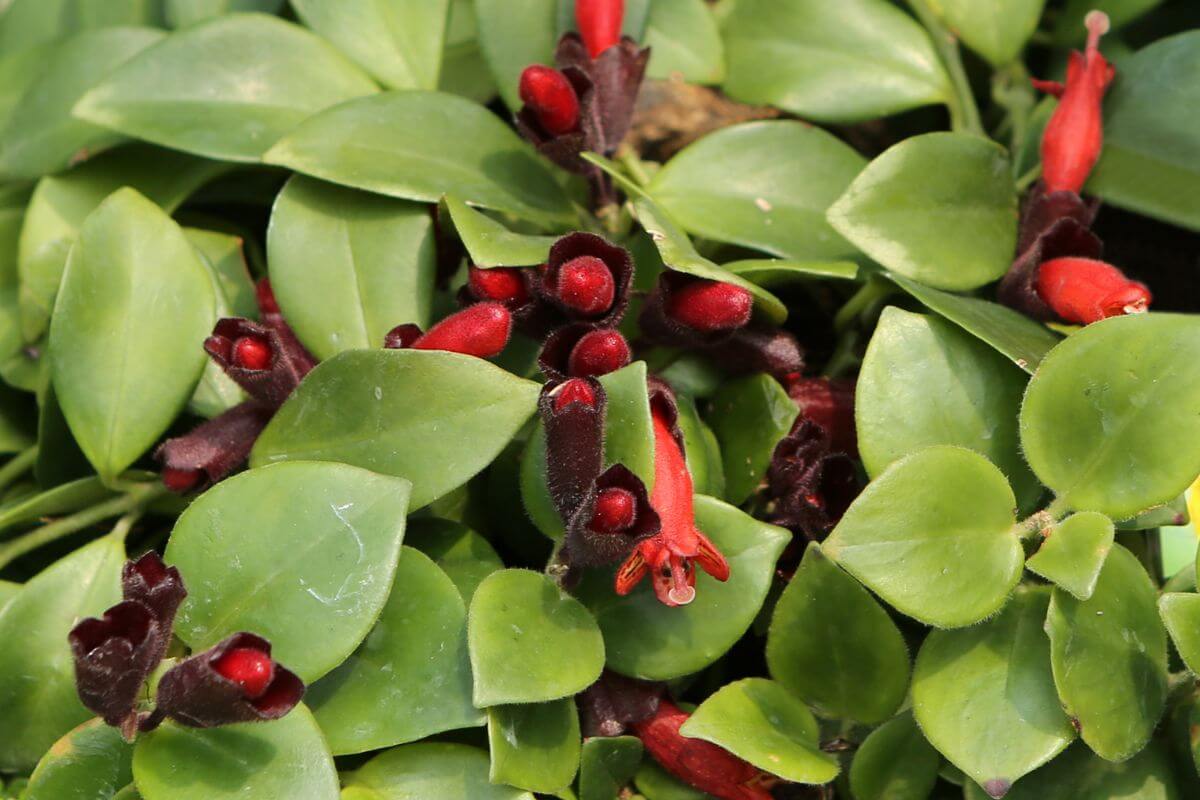
A member of the Gesneraceae family, the Lipstick Plant is botanically known as Aeschynanthus Radicans. Itis a beautiful, flowering tropical evergreen that will brighten up a room like few other houseplants.
Other names for the lipstick plant include Lipstick Vine and Basket Vine.
Native to Southeast Asia on the Malay Peninsula south of Java, the lipstick plant is an epiphytic species. In its natural habitat, it can be found growing on trees, on other plants or even on rocks.
As an epiphyte, this plant is not parasitic, but attaches itself to the host as a base for support. Epiphytes find their nutrition from the air and the rain in the humid tropical rainforest.
This plant will grow to approximately two feet in length and perhaps longer. One unusual characteristic of these plants is that they emit a rather unpleasant odor.
The plant’s genus Aeschynanthus has about 150 different tropical plant species. Because lipstick plants are quite popular, various cultivars have also been created. Among these we find:
- Variegated Lipstick Plant
- Black Pagoda Lipstick Plant
- Cassiopeia Lipstick Plant
- Curly Lipstick Plant
- Krakau Lipstick Plant
- Mona Lisa Lipstick Plant
- Purple star Lipstick Plant
- Tangerine Lipstick Plant
Lipstick Plant Care Guide
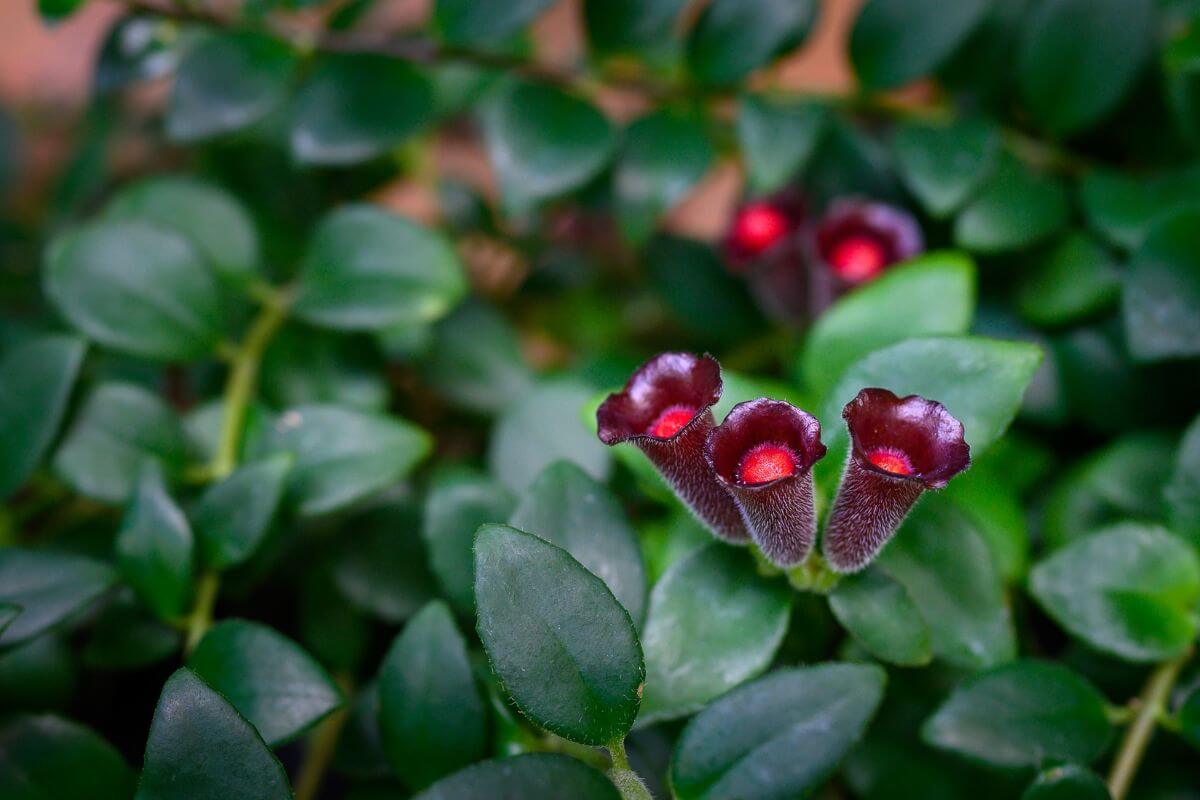
For healthy growth of the lipstick plant, be sure to keep an eye on the water, moisture, and light levels.
Soil for Lipstick Plant
In their native tropical habitats, these epiphyte plants grow by rooting onto larger plants, tree branches, and even in cracks and spaces between rocks.
Ideally, your lipstick plant’s potting soil needs to be moist, aerated, and light. A combination of sand and sphagnum moss for drainage is great, and will help avoid root rot.
Keep the soil moist and well-draining, and the plant should grow well.
Fertilizer for Lipstick Plant
Proper care for your tropical houseplant includes good nutrition to create fertile soil.
Plant feeding should take place regularly with a slow-release fertilizer during the growing season. A 3-2-1 NPK liquid fertilizer (Nitrogen-Phosphorus-Potassium) will work well, as long as the soil is moist.
Consider flushing the plant’s soil bed two or three times a year to help get rid it of mineral salt buildup.
Apart from hanging flower pots or baskets, this plant can also be cultivated on wood slabs, but must be kept moist.
Temperature for Lipstick Plant
The ideal environmental temperature range is between 70° and 85° Fahrenheit.
It can survive at 65°F and below, but will not necessarily thrive. If temperatures drop below 50° F., this plant will begin to drop foliage.
When looking for an indoor location, avoid areas subject to drafts from windows, doors, hallways, air conditioning or heating vents. This plant cannot weather abrupt changes in room temperature.
If you have warm temperatures year-round, there is a good chance of success in growing lipstick plants outdoors in winter-free climates.
Light for Lipstick Plant
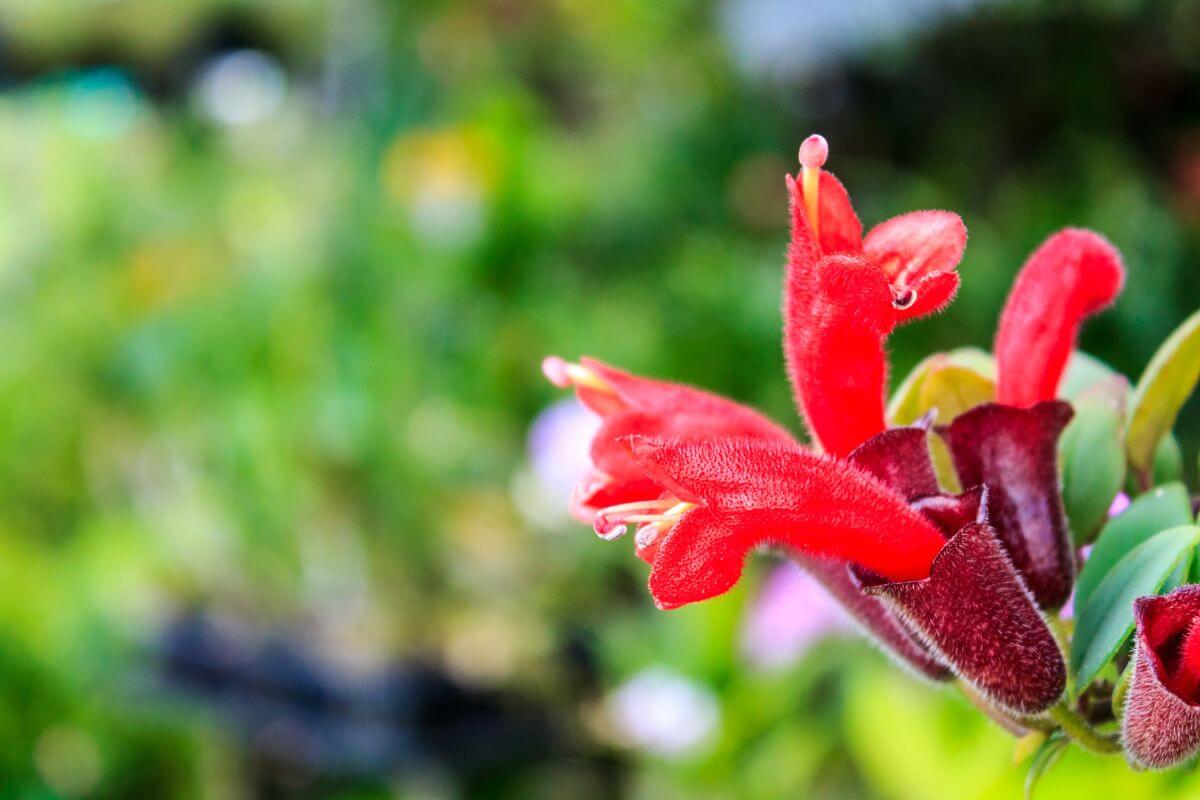
Regardless of the lipstick plant variety, they will thrive in bright indirect light. They love filtered or dappled sunlight, which ensures good growth.
Direct sunlight exposure, as well as too little light, will cause leaf drop. Direct sun can scorch leaves. Low light will result in less blooming. In both cases, the plant will suffer.
These are good south or west-facing window plants as those windows offer the right amount of light.
Water and Humidity for Lipstick Plant
The lipstick plant is from the tropical regions, so it enjoys moisture and a humid environment, especially from the spring through summer months during its growing season.
But overwatering will have a negative effect, and potentially cause the plant’s roots to rot. It can also cause foliage to drop and fungal infections.
As tropical plants, they will need their share of both humidity and warmth. Watering should be done weekly during the growing season, and only every two to three weeks during the dormancy period.
You can check soil moisture levels by placing your finger in the soil bed to determine how dry it is. If you leave it without water for too long, its foliage will turn brown and drop. Also, check the soil bed to make sure you are not overwatering.
To increase humidity levels, you can get a humidifier or set a bowl of water out.
Lipstick Plant Pruning and Repotting
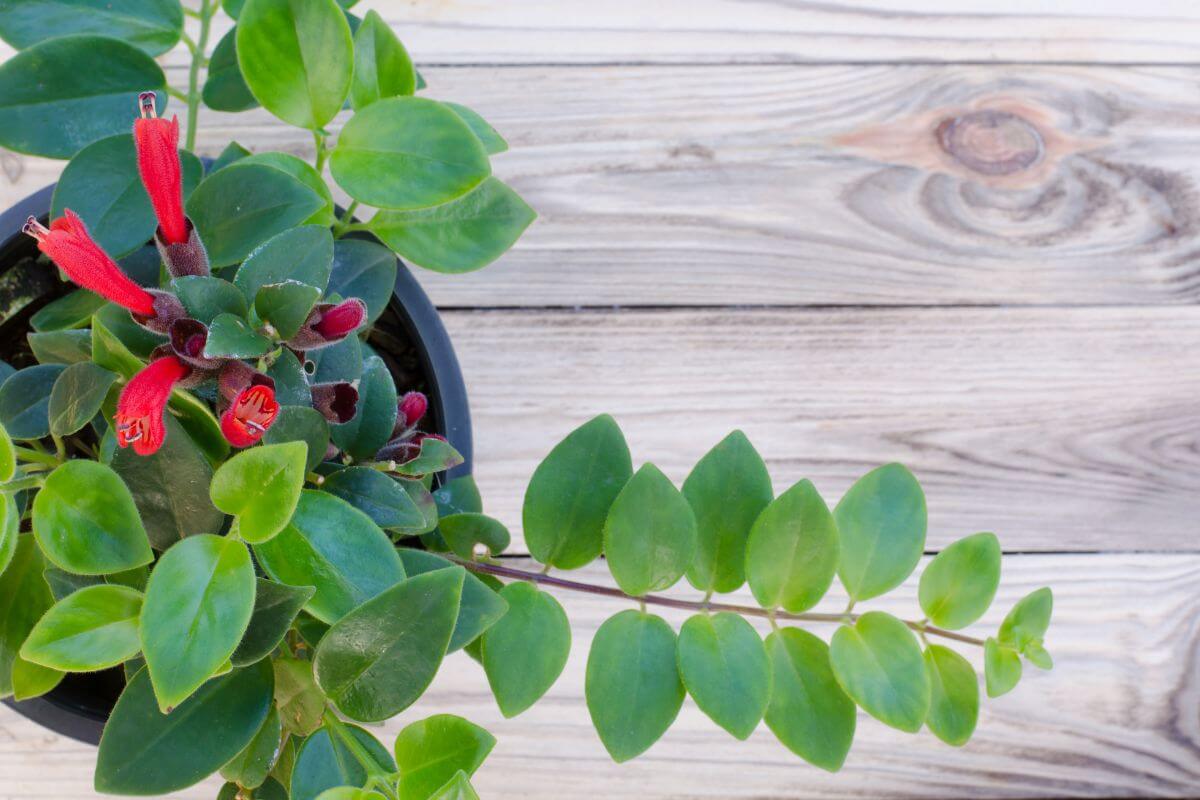
Pruning should be done to remove damaged stems, leaves or decay. You can also prune to control the plant’s size or to stimulate growth.
To prune, trim about a third of the vine once blooming has finished.
Repotting will only be necessary if the lipstick plant has outgrown its current container with the roots filling out the bottom. If that happens, choose a pot or container that is one size larger.
Repotting is recommended during the summer months when the plant is still in its growing period. Because lipstick plants flower more when they are slightly root-bound, do not repot them until absolutely necessary.
Propagating the Lipstick Plant
The lipstick plant is an easy houseplant to propagate with stem cuttings. Here’s how to propagate:
- Select a new vine on your plant and cut a section that is five to six inches in length. It should not have flowers on it and only a few leaves, so remove most of the foliage.
- Treat the cut end with root hormone before putting it in a container.
- The growing medium should be moist and the stem cutting needs to be kept warm at about 70’°F.
- It should not be exposed to direct sunlight.
- After approximately two weeks, your cutting should begin to take root.
Pro Tip: Create a mini growth chamber by placing a plastic bag over cuttings to maintain perfect humidity while waiting for roots to develop.
While it is easier to propagate using stem cuttings, lipstick plants can be propagated from seed.
The seed should be placed in a growing medium and lightly covered. They need to be kept in a warm indoor location with a temperature that measures between 70° and 75°F. After two weeks, you should see the seedlings begin to germinate.
Lipstick Plant Pests, Diseases, and More
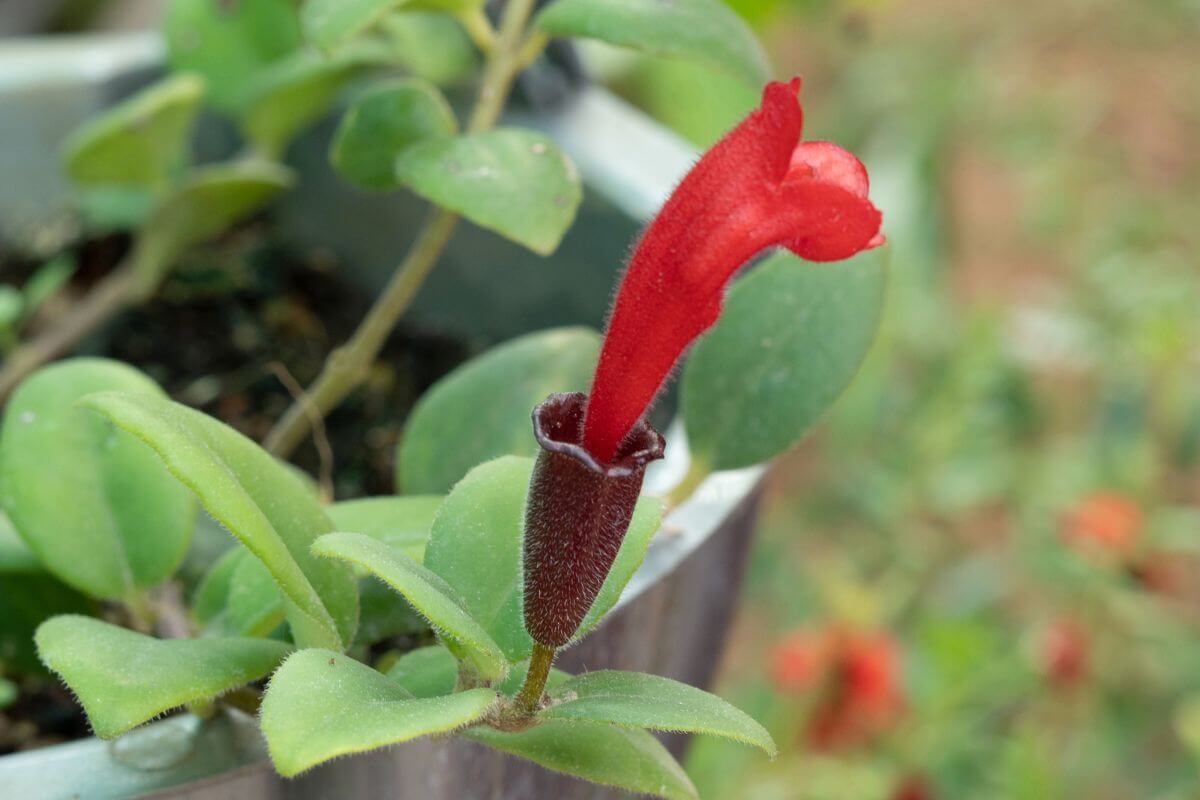
Although the lipstick plant does not have major problems with pest infestations, it can be subject to fungal diseases and to leaf spots.
That usually occurs when they are left in a growing medium that is soggy and overly wet. Foliage should never be left damp, and the soil must drain well for the health of your entire plant.
Yellow leaves indicate it’s not receiving sufficient water or sufficient light, perhaps both.
If the edges of the leaves turn brown, the plant may be receiving excessive sunlight, or it may be receiving too little water.
Reddish-brown substances found on the plant indicate a fungal problem, and it should be treated with a fungicide.
Cotton masses found on stems are a sure sign of mealybugs. Tiny pear-shaped insects are aphids, and webs on the undersides of foliage indicate spider mites.
Should you notice any pests, treat the plant with an organic insecticide such as neem oil or with an insecticidal soap.
Lipstick Plant Toxicity and Pets
The lipstick plant is non-toxic to cats, dogs and horses, so it’s safe when
Lipstick Plant Final Thoughts
Nothing will brighten up your home or office décor like a blooming houseplant. If you are a flower lover, the Lipstick Plant, when successfully cultivated, will liven up any corner with clusters of vividly colored blooms.
An easy-to-grow houseplant to cultivate, the Lipstick Plant will reward your attention and care with colorful flowers throughout the entire year.
For more houseplant care and grow guides, check these out:
- Crown of Thorns Plant Care and Grow Guide
- Nerve Plant (Fittonia) Care and Grow Guide
- Pitcher Plant Care and Grow Guide
Lipstick Plant FAQs
How much light do lipstick plants need?
Lipstick plants need indirect, bright light. Avoid direct sun exposure. They need adequate light for healthy growth and blooms. Be sure they receive indirect light for the majority of the day, but no need for all day.
Are lipstick plants easy to care for?
Yes, lipstick plants are easy to care for. The only thing you really need to remember is to keep them watered regularly and ensure there’s plenty of bright light. It doesn’t matter how dry the air gets outside; if there isn’t enough moisture inside the pot, then the plant won’t thrive. You’ll want to check daily to make sure the top inch of soil is moist and has good drainage. This means removing excess water from the bottom of the pot.
Do lipstick plants like to be misted?
Yes, most lipstick plants benefit from regular misting. Make sure you don’t overdo this though because it could cause root rot. Mist once every week during hot weather months or more regularly if you live in dry climates.
Is the lipstick plant an indoor plant?
Yes, the lipstick plant is a beautiful option as an indoor plant. They bloom as colorful miniature tubes of lipstick. These tubular flowers and its flowing vines are great as hanging plants.
Why is my lipstick plant wrinkly?
There are a number of reasons why lipstick plant leaves are becoming wrinkly, including:
1.) Grown under low lighting conditions
2.) Wasn’t given enough time to grow before being moved into new pots
3.) Had been overwatered
4.) Didn’t have enough fertilizer added
5.) Received inadequate amounts of nutrients
6.) Was exposed to high temperatures
7.) Was placed near heat sources
8.) Was kept indoors without proper ventilation
9.) Was subjected to cold drafts
How often should I water a lipstick plant?
During the growing season, Spring through Summer, plan to water the lipstick plant once per week on average. If you live in a dry climate and the soil dries out quickly, you may need to water more regularly. During its dormant period in the Fall and Winter, watering once every 2-3 weeks should be enough.
Is the lipstick plant a succulent?
No, the lipstick plant isn’t a succulent. It’s an evergreen flowering, tropical houseplant that produces colorful flowers in the shape of lipstick tubes.
Are lipstick plants poisonous?
No, lipstick plants aren’t poisonous. Feel free to grow them at home if you have cats and dogs!



Thank you for the information on the care of the plant. I will be following these for sure.
Much appreciated.
Terry